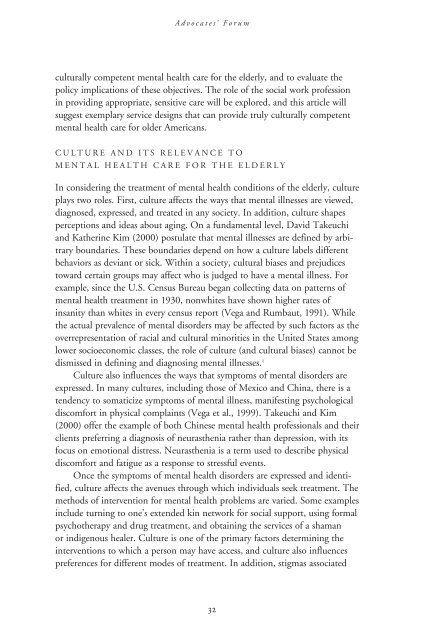2004 - School of Social Service Administration - University of Chicago
2004 - School of Social Service Administration - University of Chicago
2004 - School of Social Service Administration - University of Chicago
You also want an ePaper? Increase the reach of your titles
YUMPU automatically turns print PDFs into web optimized ePapers that Google loves.
Advocates’ Forum<br />
culturally competent mental health care for the elderly, and to evaluate the<br />
policy implications <strong>of</strong> these objectives. The role <strong>of</strong> the social work pr<strong>of</strong>ession<br />
in providing appropriate, sensitive care will be explored, and this article will<br />
suggest exemplary service designs that can provide truly culturally competent<br />
mental health care for older Americans.<br />
CULTURE AND ITS RELEVANCE TO<br />
MENTAL HEALTH CARE FOR THE ELDERLY<br />
In considering the treatment <strong>of</strong> mental health conditions <strong>of</strong> the elderly, culture<br />
plays two roles. First, culture affects the ways that mental illnesses are viewed,<br />
diagnosed, expressed, and treated in any society. In addition, culture shapes<br />
perceptions and ideas about aging. On a fundamental level, David Takeuchi<br />
and Katherine Kim (2000) postulate that mental illnesses are defined by arbitrary<br />
boundaries. These boundaries depend on how a culture labels different<br />
behaviors as deviant or sick. Within a society, cultural biases and prejudices<br />
toward certain groups may affect who is judged to have a mental illness. For<br />
example, since the U.S. Census Bureau began collecting data on patterns <strong>of</strong><br />
mental health treatment in 1930, nonwhites have shown higher rates <strong>of</strong><br />
insanity than whites in every census report (Vega and Rumbaut, 1991). While<br />
the actual prevalence <strong>of</strong> mental disorders may be affected by such factors as the<br />
overrepresentation <strong>of</strong> racial and cultural minorities in the United States among<br />
lower socioeconomic classes, the role <strong>of</strong> culture (and cultural biases) cannot be<br />
dismissed in defining and diagnosing mental illnesses. 1<br />
Culture also influences the ways that symptoms <strong>of</strong> mental disorders are<br />
expressed. In many cultures, including those <strong>of</strong> Mexico and China, there is a<br />
tendency to somaticize symptoms <strong>of</strong> mental illness, manifesting psychological<br />
discomfort in physical complaints (Vega et al., 1999). Takeuchi and Kim<br />
(2000) <strong>of</strong>fer the example <strong>of</strong> both Chinese mental health pr<strong>of</strong>essionals and their<br />
clients preferring a diagnosis <strong>of</strong> neurasthenia rather than depression, with its<br />
focus on emotional distress. Neurasthenia is a term used to describe physical<br />
discomfort and fatigue as a response to stressful events.<br />
Once the symptoms <strong>of</strong> mental health disorders are expressed and identified,<br />
culture affects the avenues through which individuals seek treatment. The<br />
methods <strong>of</strong> intervention for mental health problems are varied. Some examples<br />
include turning to one’s extended kin network for social support, using formal<br />
psychotherapy and drug treatment, and obtaining the services <strong>of</strong> a shaman<br />
or indigenous healer. Culture is one <strong>of</strong> the primary factors determining the<br />
interventions to which a person may have access, and culture also influences<br />
preferences for different modes <strong>of</strong> treatment. In addition, stigmas associated<br />
32
















